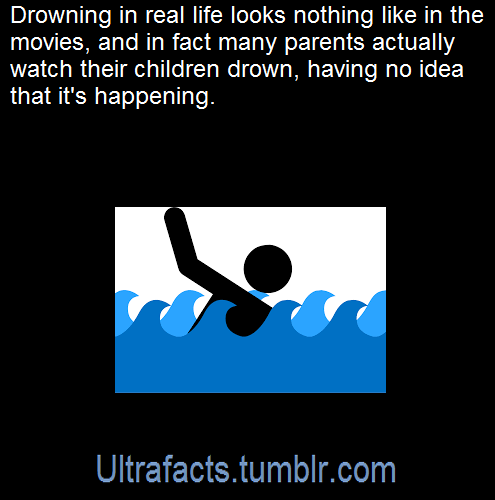Follow Ultrafacts For More Facts!

According to the CDC, in 10 percent of those drownings, the adult will actually watch the child do it, having no idea it is happening. Drowning does not look like drowning—Dr. Pia, in an article in the Coast Guard’s On Scene magazine, described the Instinctive Drowning Response like this:
“Except in rare circumstances, drowning people are physiologically unable to call out for help. The respiratory system was designed for breathing. Speech is the secondary or overlaid function. Breathing must be fulfilled before speech occurs.
Drowning people’s mouths alternately sink below and reappear above the surface of the water. The mouths of drowning people are not above the surface of the water long enough for them to exhale, inhale, and call out for help. When the drowning people’s mouths are above the surface, they exhale and inhale quickly as their mouths start to sink below the surface of the water.
Drowning people cannot wave for help. Nature instinctively forces them to extend their arms laterally and press down on the water’s surface. Pressing down on the surface of the water permits drowning people to leverage their bodies so they can lift their mouths out of the water to breathe.
Throughout the Instinctive Drowning Response, drowning people cannot voluntarily control their arm movements. Physiologically, drowning people who are struggling on the surface of the water cannot stop drowning and perform voluntary movements such as waving for help, moving toward a rescuer, or reaching out for a piece of rescue equipment.
From beginning to end of the Instinctive Drowning Response people’s bodies remain upright in the water, with no evidence of a supporting kick. Unless rescued by a trained lifeguard, these drowning people can only struggle on the surface of the water from 20 to 60 seconds before submersion occurs.”
This doesn’t mean that a person that is yelling for help and thrashing isn’t in real trouble—they are experiencing aquatic distress. Not always present before the Instinctive Drowning Response, aquatic distress doesn’t last long—but unlike true drowning, these victims can still assist in their own rescue. They can grab lifelines, throw rings, etc.
Look for these other signs of drowning when persons are in the water:
Head low in the water, mouth at water level
Head tilted back with mouth open
Eyes glassy and empty, unable to focus
Eyes closed
Hair over forehead or eyes
Not using legs—vertical
Hyperventilating or gasping
Trying to swim in a particular direction but not making headway
Trying to roll over on the back
Appear to be climbing an invisible ladder
So if a crew member falls overboard and everything looks OK—don’t be too sure. Sometimes the most common indication that someone is drowning is that they don’t look like they’re drowning. They may just look like they are treading water and looking up at the deck. One way to be sure? Ask them, “Are you all right?” If they can answer at all—they probably are. If they return a blank stare, you may have less than 30 seconds to get to them. And parents—children playing in the water make noise. When they get quiet, you get to them and find out why.
Source/article: [x]
Follow Ultrafacts for more facts!
More Posts from Oracleofthepast and Others
In linguistics, a filler is a sound or word that is spoken in conversation by one participant to signal to others that he/she has paused to think but is not yet finished speaking. These are not to be confused with placeholder names, such as thingamajig, which refer to objects or people whose names are temporarily forgotten, irrelevant, or unknown.
In Afrikaans, ah, em, and eh are common fillers.
In Arabic, يعني yaʿni (“I mean”) and وﷲ wallāh(i) (“by God”) are common fillers.[2][3][4]
In American Sign Language, UM can be signed with open-8 held at chin, palm in, eyebrows down (similar to FAVORITE); or bilateral symmetric bent-V, palm out, repeated axial rotation of wrist (similar to QUOTE).
In Bengali, mane (“it means”) is a common filler.
In Catalan, eh /ə/, doncs (“so”), llavors (“therefore”), and o sigui (“it means”) are common fillers.
In Czech, tak or takže (“so”), prostě (“simply”), jako (“like”) are used as fillers. Čili (“or”) and že (“that”, a conjunction) might also be others. A person who says jako and prostě as fillers might sound a bit simple-minded to others.[5]
In Danish, øh is one of the most common fillers.
In Dutch, eh, ehm, and dus are some of the more common fillers.
In Esperanto, do (“therefore”) is the most common filler.
In Filipino, ah, eh, ay, and ano are the most common fillers.
In Finnish, niinku (“like”), tota, and öö are the most common fillers.
In French, euh /ø/ is most common; other words used as fillers include quoi (“what”), bah, ben (“well”), tu vois (“you see”), and eh bien (roughly “well”, as in “Well, I’m not sure”). Outside of France, other expressions are tu sais (“you know”), t’sais’veux dire? (“you know what I mean?”), or allez une fois (“go one time”). Additional filler words include genre (“kind”), comme (“like”), and style (“style”; “kind”)
In German, a more extensive series of filler words, called modal particles, exists, which actually do give the sentence some meaning. More traditional filler words are äh /ɛː/, hm, so /zoː/, tja, and eigentlich (“actually”)
In Hebrew, eh is the most common filler. Em is also quite common.
In Hindi, matlab (“it means”) and “Mah” are fillers.
In Hungarian, common filler words include hát (well…) and asszongya (a variant of azt mondja, which means “it says here…”).
In Icelandic, a common filler is hérna (“here”). Þúst, a contraction of þú veist (“you know”), is popular among younger speakers.
In Indonesian (Bahasa Indonesia), anu is one of the most common fillers.
In Italian, common fillers include “tipo” (“like”), “ecco” (“there”) and “cioè” (“actually”)
In Irish Gaelic, abair /ˈabˠəɾʲ/ (“say”), bhoil /wɛlʲ/ (“well”), and era /ˈɛɾˠə/ are common fillers, along with emm as in Hiberno-English.
In Japanese, common fillers include eetto, ano, sono, and ee.
In Kannada,Matte for also,Enappa andre for the matter is are the common fillers.
In Korean, eung, eo, ge, and eum are commonly used as fillers.
In Lithuanian, nu, am and žinai (“you know”) are common fillers.
IN Maltese and Maltese English, mela (“then”), or just la, is a common filler.
In Mandarin Chinese, speakers often say 这个 zhège/zhèige (“this”) or 那个 nàge/nèige (“that”). Another common filler is 就 jìu (“just/precisely”).
In Norwegian, common fillers are øh, altså, på en måte (“in a way”), ikke sant (literally “not true?”, “no kidding”, or “exactly”), vel (“well”), and liksom (“like”). In Bergen, sant (“true”) is often used instead of ikke sant. In the Trøndelag region, skjø’ (“see?” or “understand?”) is also a common filler.
In Persian, bebin (“you see”), چیز “chiz” (“thing”), and مثلا masalan (“for instance”) are commonly-used filler words. As well as in Arabic and Urdu, يعني yaʿni (“I mean”) is also used in Persian. Also, eh is a common filler in Persian.
In Portuguese, tipo (“like”) is the most common filler.
In Romanian, deci /detʃʲ/ (“therefore”) is common, especially in school, and ă /ə/ is also very common (can be lengthened according to the pause in speech, rendered in writing as ăăă), whereas păi /pəj/ is widely used by almost anyone.
In Russian, fillers are called слова-паразиты (“vermin words”); the most common are Э-э (“eh”), это (“this”), того (“that”), ну (“well”), значит (“it means”), так (“so”), как его (“what’s it [called]”), типа (“like”), and как бы (“[just] like”).
In Serbian, znači (“means”) and ovaj (“this”) are common fillers.
In Slovak, oné (“that”), tento (“this”), proste (“simply”), or akože are used as fillers. The Hungarian izé (or izí in its Slovak pronunciation) can also be heard, especially in parts of the country with a large Hungarian population. Ta is a filler typical of Eastern Slovak and one of the most parodied features.
In Slovene, pač (“but”, although it has lost that meaning in colloquial, and it is used as a means of explanation), a ne? (“right?”), and no (“well”) are some of the fillers common in central Slovenia, including Ljubljana.
In Spanish, fillers are called muletillas. Some of the most common in American Spanish are e /e/, este (“this”), and o sea (roughly means “I mean”).[6], in Spain the previous fillers are also used, but ¿Vale? (“right?”) and ¿no? are very common too.
In Swedish, fillers are called utfyllningsord; some of the most common are öhm, ja (“yes”), ba (comes from “bara”, which means “just”), asså or alltså (“therefore”, “thus”), va (comes from “vad”, which means “what”), and liksom and typ (both similar to the English “like”).
In Ukrainian, ой /ɔj/ is a common filler.
In Urdu, yani (“meaning…”), falan falan (“this and that”; “blah blah”), umm, and aaa are also common fillers.
In Telugu, ikkada entante (“Whats here is…”) and tarwatha (“then…”) are common and there are numerous like this.
In Tamil, paatheenga-na (“if you see…”) and apparam (“then…”) are common.
In Turkish, yani (“meaning…”), şey (“thing”), “işte” (“that is”), and falan (“as such”, “so on”) are common fillers.
In Welsh, de or ynde is used as a filler (loosely the equivalent of “You know?” or “Isn’t it?”). Ym… and Y… are used similarly to the English “um…”.
To people who are desperately asking for fundz/donations on tumblr.
USE THESE REDDIT SUBS INSTEAD PLEASE FOR GOODNESS SAKE!!!!!!!!!
Hate Reddit if you want, but using these subs are your best chance. People gather in these subs because they have charity to spare:
/r/Assistance /r/legaladvice /r/RandomKindness /r/Charity /r/care /r/Random_Acts_Of_Pizza /r/Food_Pantry https://www.reddit.com/r/RandomActsOfPetFood/ https://www.reddit.com/r/RandomActsOfChristmas/ https://www.reddit.com/r/almosthomeless/ https://www.reddit.com/r/homeless
/r/freelance /r/povertyfinance /r/thrifty /r/borrow /r/gofundme
/r/depression /r/familysupport /r/transitions
I never see anyone actually getting any significant donations on tumblr and to be honest, tumblr is the worst place to ask for assistance. Use it as your last resort, it frustrates me to no end seeing people begging for help, reblogging the same post over and over, the same types of posts over and over, to no avail, when people are waiting to help you on a different part of the web GO TO WHERE THE HELP IS. IF YOU WANT DIRECT ACTION TO WORK STOP WITH TUMBLR AND USE REDDIT.
PLEASE FOR THE LOVE OF SATAN REBLOG THIS SO WE CAN START REDUCING THE AMOUNT OF DONATION POSTS THAT GET STUCK FLOATING AROUND THIS WEBSITE
At first, all seems normal. But then, just as you were about to leave the classroom, you and all of your classmates noticed that the door was gone.
“Who did it‽ Who divided by zero‽” your teacher yells, clawing at the walls.
You slowly raise your hand with your feeble excuse of “I just wanted to see what would happen.”
The teacher tries to explain why you should never have done that, but alas, it is too late. The floor opens up, as well as the walls. The end is upon us, you realize, before you are sucked into the black hole that formed.
Your math teacher has always warned you to “NEVER EVER divide by 0.” One day, you decide to see what happens when you divide by zero.


me @ AO3

So proud of my mother for doing her own research after I sent her that meme. A sign she hung in her car window.

Helpful Diagram!!

I was in a kitchen with coworkers, crouched on top of the fridge. A sheriff’s deputy came in and asked if we were the ones hunting the lions. A not too bright coworker said that we were, despite that not being true whatsoever, and I was mad because this would ruin the reputation of our workplace. Then a lion crashed through the window, we escaped and ran through the woods to a playground. We climbed the playground and I foolishly thought that we were safe but I forgot that lions can leap.
more on writing muslim characters from a hijabi muslim girl
- hijabis get really excited over pretty scarves - they also like to collect pins and brooches - we get asked a lot of questions and it can be annoying or it can be amusing, just depends on our mood and personality and how the question is phrased - common questions include: - “not even water?” (referring to fasting) - hijabis hear a lot of “do you sleep in that?” (we don’t) and “where is your hair?” (in a bun or a braid, usually) - “is it mooze-slim or mozzlem?” (the answer is neither, it’s muslim, with a soft s and accent on the first syllable) - “ee-slam or iz-lamb?” (it’s iss-laam, accent on the first syllable) - “hee-job?” (heh-jahb, accent on the second syllable)
- “kor-an?” (no. quran. say it like koor-annn, accent on the second syllable) - people tend to mess up our names really badly and you just get a sigh and a resigned nod or an awkward smile, maybe a nickname instead - long hair is easy to hide, short hair is harder to wrap up - hijab isn’t just covering hair, it’s also showing as little skin as possible with the exception of face, hands, and feet, and not wearing tight/sheer clothing - that applies to men too, people just don’t like to mention it ( i wonder why) - henna/mehendi isn’t just for special occasions, you’ll see people wearing it for fun - henna/mehendi isn’t just for muslims, either, it’s not a religious thing - henna/mehendi is not just for women, men also wear it, especially on their weddings - there are big mehendi parties in the couple of nights before eid where people (usually just women and kids) gather and do each other’s mehendi, usually just hands and feet - five daily prayers - most muslim kids can stutter through a couple verses of quran in the original arabic text by the age of seven or eight, it does not matter where they live or where they’re from or what language they speak natively - muslim families tend to have multiple copies of the quran - there are no “versions” of the quran, there has only ever been one. all muslims follow the exact same book - muslims have no concept of taking God’s name in vain, we call on God at every little inconvenience - don’t use islamic phrases if you don’t know what they mean or how to use them. we use them often, inside and outside of religious settings. in islam, it is encouraged to mention God often and we say these things very casually, but we take them very seriously - Allahu Akbar means “God is Greatest” (often said when something shocks or surprises us, or if we’re scared or daunted, or when something amazing happens, whether it be good or bad; it’s like saying “oh my god”) - Subhan Allah means “Glory be to God” (i say subhan Allah at the sky, at babies, at trees, whatever strikes me as pleasant, especially if it’s in nature) - Bismillah means “in the name of God” and it’s just something you say before you start something like eating or doing your homework - In Shaa Allah means “if God wills” (example: you’ll be famous, in shaa Allah) (it’s a reminder that the future is in God’s hands, so be humble and be hopeful)
- Astaghfirullah means “i seek forgiveness from Allah” and it’s like “god forgive me” - Alhamdulillah means “all thanks and praise belong to God” and it’s just a little bit more serious than saying “thank god” (example: i passed my exams, alhamdulillah; i made it home okay, alhamdulillah) - when i say we use them casually, i really mean it - teacher forgot to assign homework? Alhamdulillah - our version of “amen” is “ameen” - muslims greet each other with “assalamu alaikum” which just means “peace be on you” and it’s like saying hi - the proper response is “walaikum assalam” which means “and on you be peace” and it’s like saying “you too”
10,000 reblogs and I will translate the script of Bee Movie into a language that I will invent solely for this purpose
-
 atsa-reference reblogged this · 2 weeks ago
atsa-reference reblogged this · 2 weeks ago -
 mysteriousflamingos reblogged this · 3 weeks ago
mysteriousflamingos reblogged this · 3 weeks ago -
 mysteriousflamingos liked this · 3 weeks ago
mysteriousflamingos liked this · 3 weeks ago -
 fostertheory reblogged this · 3 weeks ago
fostertheory reblogged this · 3 weeks ago -
 duelfeather-art liked this · 1 month ago
duelfeather-art liked this · 1 month ago -
 76ello reblogged this · 1 month ago
76ello reblogged this · 1 month ago -
 polkadot-creeper liked this · 1 month ago
polkadot-creeper liked this · 1 month ago -
 desfraisespartout reblogged this · 1 month ago
desfraisespartout reblogged this · 1 month ago -
 dragonfly-general reblogged this · 2 months ago
dragonfly-general reblogged this · 2 months ago -
 marlovestrees reblogged this · 2 months ago
marlovestrees reblogged this · 2 months ago -
 whisperingballoon liked this · 2 months ago
whisperingballoon liked this · 2 months ago -
 whisperingballoon reblogged this · 2 months ago
whisperingballoon reblogged this · 2 months ago -
 whorechatas reblogged this · 3 months ago
whorechatas reblogged this · 3 months ago -
 spookysshadow reblogged this · 3 months ago
spookysshadow reblogged this · 3 months ago -
 blueberrypuffins liked this · 3 months ago
blueberrypuffins liked this · 3 months ago -
 texasturtlefan reblogged this · 4 months ago
texasturtlefan reblogged this · 4 months ago -
 heckcareoxytwit liked this · 5 months ago
heckcareoxytwit liked this · 5 months ago -
 annaiw106 liked this · 6 months ago
annaiw106 liked this · 6 months ago -
 annao81ly liked this · 6 months ago
annao81ly liked this · 6 months ago -
 notgonnapost4 reblogged this · 7 months ago
notgonnapost4 reblogged this · 7 months ago -
 notgonnapost4 liked this · 7 months ago
notgonnapost4 liked this · 7 months ago -
 21kln647xpyih5ewgqgslvvfa reblogged this · 7 months ago
21kln647xpyih5ewgqgslvvfa reblogged this · 7 months ago -
 21kln647xpyih5ewgqgslvvfa liked this · 8 months ago
21kln647xpyih5ewgqgslvvfa liked this · 8 months ago -
 violatime reblogged this · 8 months ago
violatime reblogged this · 8 months ago -
 violatime liked this · 8 months ago
violatime liked this · 8 months ago -
 modularnra40 reblogged this · 8 months ago
modularnra40 reblogged this · 8 months ago -
 modularnra40 liked this · 8 months ago
modularnra40 liked this · 8 months ago -
 marlovestrees reblogged this · 8 months ago
marlovestrees reblogged this · 8 months ago -
 itsmedontpanic liked this · 8 months ago
itsmedontpanic liked this · 8 months ago -
 wrongfulnoodle3120 reblogged this · 8 months ago
wrongfulnoodle3120 reblogged this · 8 months ago -
 wrongfulnoodle3120 liked this · 8 months ago
wrongfulnoodle3120 liked this · 8 months ago -
 roboremy liked this · 8 months ago
roboremy liked this · 8 months ago -
 nyrithsamandri reblogged this · 8 months ago
nyrithsamandri reblogged this · 8 months ago -
 nyrithsamandri liked this · 8 months ago
nyrithsamandri liked this · 8 months ago -
 rainbowdelicsunshine reblogged this · 8 months ago
rainbowdelicsunshine reblogged this · 8 months ago -
 rainbowdelicartz liked this · 8 months ago
rainbowdelicartz liked this · 8 months ago -
 thetideizhigh reblogged this · 8 months ago
thetideizhigh reblogged this · 8 months ago -
 sanctuaryforalluniverses reblogged this · 8 months ago
sanctuaryforalluniverses reblogged this · 8 months ago -
 felren13 reblogged this · 8 months ago
felren13 reblogged this · 8 months ago -
 the-tomorrow-road reblogged this · 8 months ago
the-tomorrow-road reblogged this · 8 months ago -
 the-tomorrow-road liked this · 8 months ago
the-tomorrow-road liked this · 8 months ago -
 aeshnacyanea2000 reblogged this · 8 months ago
aeshnacyanea2000 reblogged this · 8 months ago -
 waitingforanonshittydayinhell reblogged this · 9 months ago
waitingforanonshittydayinhell reblogged this · 9 months ago -
 thisiswhereilearntolovemyself liked this · 9 months ago
thisiswhereilearntolovemyself liked this · 9 months ago -
 bastard-sweet reblogged this · 9 months ago
bastard-sweet reblogged this · 9 months ago -
 mommawitchbitxh reblogged this · 9 months ago
mommawitchbitxh reblogged this · 9 months ago -
 unscrupuloussnook reblogged this · 10 months ago
unscrupuloussnook reblogged this · 10 months ago
